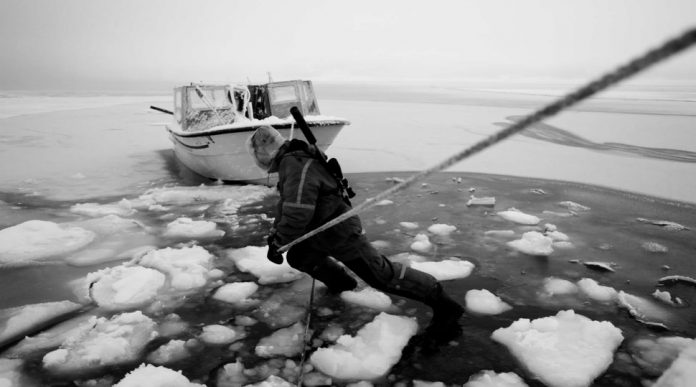(THIS ARTICLE IS MACHINE TRANSLATED by Google from Norwegian)
With her first full-length documentary, 69 minutes of 86 days (2017), Egil Håskjold Larsen made himself strongly noted as a new talent in Norwegian documentary film. For the film he received, among other things, the Gold Route Award, the Gold Chair for Best Documentary at the Short Film Festival in Grimstad and the Emerging International Filmmaker Award at the important documentary festival Hot Docs in Canada.
The 69 minutes of 86 days following Syrian refugees on their way through Europe from the perspective of a little girl, Håskjold Larsen in his new film has pointed the camera at an elderly man at the "extreme tip", north of Finnmark. Where to return is about seventy year old Steinar, who lives an isolated life close to nature, one kilometer from the border with Russia.
monologue
We are introduced to the main character while he is out with the boat and catches a seal, before returning with the catch to the small house he lives in with the dog Tussi. We meet no other people during the movie's playing time. However, the documentary is not completely free of dialogue, or perhaps rather monologue: Regularly we hear Steinar talk – whether it be to the dog, the filmmaker or himself – as well as having a radio that gives him company and, not least, sports updates. Quite early in the documentary, Steinar is also called (he has a cellphone, though not always turned on) by his daughter, who says that he has become a grandfather. The news is welcomed with pleasure, but there is no mention of possibly coming and greeting the newborn granddaughter. Another scene shows a picture of a younger Steinar with his son.
belonging
Beyond this, the observing film provides strikingly sparse background information about the protagonist, before any text posters at the end of the film say anything – but not much – about it.

Then too, Steinar's existence seems to be more about what is happening here and now than about what belongs to the past. He is watching closely for the wildlife around him and is constantly going out to sink food for himself and Tussi. As well as to fight some folk ravens that threaten the other birds in the area. It is obvious among nature and animals he feels belonging, not in civilization.
Like 69 minutes of 86 days, and his previous map documentary Ad Astra (2016), is Where to return photographed by the director himself – who also has experience as a photographer for other filmmakers. Here he has chosen to photograph in black and white, which highlights the cold and brutal aspects of the landscape, while at the same time reinforcing the film's contemplative and partly poetic visual expression.
experiences
Håskjold Larsen is not the first Norwegian documentary who has taken an interest in people who have little to do with a modern lifestyle. For example, Øyvind Sandberg in Å has sailed his own sea (2002) and People at the fjord (2011) depicted Norwegians living in a more traditional way than most of us, while Sjur Paulsens loop (2005) was about people seeking nature – albeit with more focus on our relationship with time. The aging farmers Oddny and Magnar in Frode Fimlands The sibling forever (2013) has received both a sequel film and book release, and the NRK series No one would think anyone could bu has rolled and walked the screens of the thousand homes for up to 17 seasons.
In other words, portrayals of people who have chosen a more traditional – and often isolated – life on the outskirts of civilization seem to hit a nerve in both Norwegian filmmakers and their audiences. And it may not be so strange, all the time these films deal very closely with man's relationship to nature. We live in a country with much nature, and our virtually collective passion for cabin life and walks in the woods and fields testifies to our commitment to experience it. The films preferably depict people living in harmony with nature – however inhospitable it may be. In addition, presumably some of the appeal lies in being reminded of how many people in this country lived in a relatively close past – which is just as remote enough to appear as a tinge of romance.
This is not about nostalgically cultivating the earth in the "old fashioned way".
At the same time, we are living in a time when nature is getting closer, with increasing violence. This aspect can be read in Egil Håskjold Larsen's documentary, which at certain points differs from the aforementioned films. Where to return is not about insisting on cultivating the earth in the "old way", but about survival and presence in a wild and powerful nature – even if there is an insistent stubbornness here too.
The film also contains beauty and contemplation, but is not distinctly romantic, at least not in a nostalgic or sentimental way. With fairly subtle grasp – and all the while respecting its protagonist – the film gives a sense of what sacrifices are required if one is to give up more or less renunciation of civilization. However, this is not a documentary that is primarily intended to explain. Instead, it wants to convey a sense of this uncompromising, strenuous and withdrawn life – and in that, there may well be as much understanding.
Where to return has a world premiere at Tromsø International Film Festival (January 14-20), where it is the opening film of the festival.


